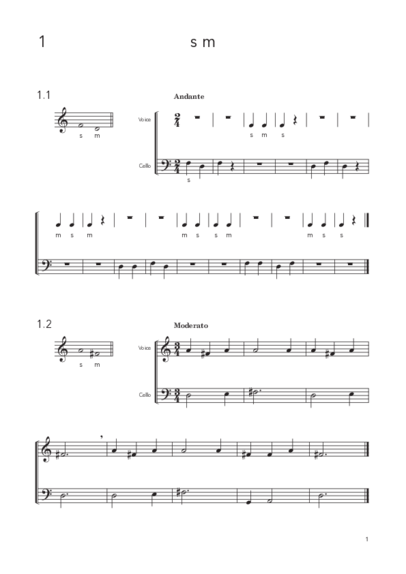Description of the Exercises
Inspired by the powerful impact that singing and playing has on the development of musicianship skills, and motivated by the fact that not enough specific material is out there to practice consistently singing and playing on the cello, I decided to write myself a series of 40 exercises for singing and playing on the cello.
I aim to use these exercises in my own practice as well as in my teaching practice, and I hope they will be found inspiring by fellow cellists: teachers, students and colleagues.
The book contains 40 exercises for voice and cello written and arranged with the objective of developing a profound coordination and control in playing by means of singing while playing a second part on the cello.
The book is divided in 6 parts, the first 5 parts featuring exercises with different grades of complexity based on different melodic tonesets. Every new toneset is introduced first with melodies written combining sol-fa syllables with a rhythmic line without the use of the staff. The last part of the book contains examples of music taken from the repertoire, where singing and playing can be practiced together.
All melodies in this book can be sung using the solmisation system. The syllables do, re, mi, sol, la, are abbreviated in: d r m s l.
The different melodic sets are introduced as follows in the table below.
Writing Approach
The following are the aspects I have taken in consideration when writing the exercises as derived from the literature and in accordance to the Kodály concept.
- Singing should be in solmisation.
- Different tonesets should be introduced gradually, to reach the final pentatonic toneset.
- Notation can be introduced gradually (reading from sol-fa notation, to staff notation).
- Canonic material is of meaningful value.
- The singing should fit the vocal range of the student.
- Exercises should have space for variation: different cello techniques are featured (different bow strokes, natural harmonics, shifting, thumb position, different dynamics).
Part 6 of the exercises consists of singing and playing exercises taken from the cello repertoire including cello sonatas, chamber music and orchestral parts; I have found that in my own practice, when approaching a new chamber music piece or orchestral part, I find very useful to sing the other voices to provide a clearer picture and put the role of the cello into musical context. I will expose the benefits that singing and playing grants in relation to preparing a piece of repertoire in the next chapter.
|
1. |
s m |
m s |
s s |
m m |
|
|
|
|
|
|
|
|
|
|
|
2. |
s m l |
s l m |
m s l |
m l s |
l m s |
l s m |
|
|
|
|
|
|
|
|
|
3. |
s m d |
s d m |
d m s |
d s m |
m d s |
m s d |
|
|
|
|
|
|
|
|
|
4. |
m r d |
m d r |
d r m |
d m r |
r d m |
r m d |
|
|
|
|
|
|
|
|
|
5. |
l s m r d |
l s m d r |
d r m s l |
d r m l s |
m l s r d |
m l s d r |
|
|
s m d r l |
s m d l r |
m r d s l |
m r d l s |
l m s d r |
l m s r d |
|
|
s d m l r |
s d m r l |
m s l d r |
m s l r d |
d s m r l |
d s m l r |
|
|
s l m r d |
s l m d r |
r m d s l |
r m d l s |
m d r s l |
m d r l s |
|
|
s m l d r |
s m l r d |
m s d r l |
m s d l r |
d m r s l |
d m r l s |
|
|
d m s l r |
d m s r l |
m d s l r |
m d s r l |
r d m s l |
r d m l s |
